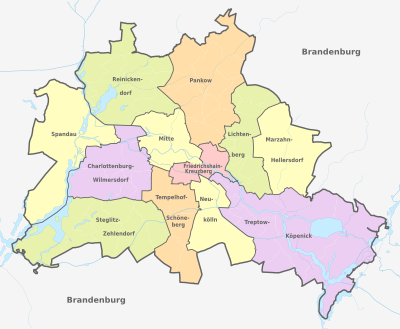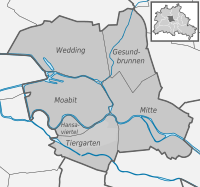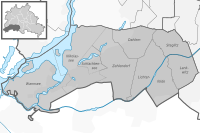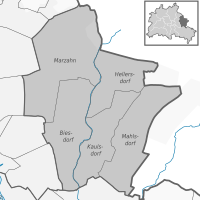
Friedrichshain-Kreuzberg is the second borough of Berlin, formed in 2001 by merging the former East Berlin borough of Friedrichshain and the former West Berlin borough of Kreuzberg. The historic Oberbaum Bridge, formerly a Berlin border crossing for pedestrians, links both districts across the river Spree as the new borough's landmark.

Pankow is the second largest area of Berlin by population. In Berlin's 2001 administrative reform, it was merged with the former boroughs of Prenzlauer Berg and Weißensee; the resulting borough retained the name Pankow. Pankow was sometimes claimed by the Western Allies to be the capital of the German Democratic Republic, while the German Democratic Republic itself considered East Berlin to be its capital.

Marzahn-Hellersdorf is the tenth borough of Berlin, formed in 2001 by merging the former boroughs of Marzahn and Hellersdorf.

Lichtenberg is the eleventh borough of Berlin, Germany. In Berlin's 2001 administrative reform it absorbed the former borough of Hohenschönhausen.

Rummelsburg is a subdivision or neighborhood (Ortsteil) of the borough (Bezirk) of Lichtenberg of the German capital, Berlin.
The Greater Berlin Act, officially Law Regarding the Creation of the New Municipality of Berlin, was a law passed by the Prussian state government in 1920, which greatly expanded the size of the Prussian and German capital of Berlin.

The state flag of Berlin, Germany has three stripes of red-white-red, the two outer stripes each occupying a fifth of its height, the middle the remaining three-fifths. It is emblazoned with a bear on the civil flag, while it bears the coat of arms of Berlin on the state flag.

Lichtenberg is a quarter (Ortsteil) of Berlin in the homonymous borough (Bezirk) of Lichtenberg. Until 2001 it was an autonomous district with the localities of Fennpfuhl, Rummelsburg, Friedrichsfelde and Karlshorst.

Neukölln, from 1899 to 1920 an independent city, is a large inner-city quarter (Ortsteil) of Berlin in the homonymous borough (Bezirk) of Neukölln, including the historic village of Rixdorf and numerous Gründerzeit estates. With 163,735 inhabitants (2024) the quarter is the second-most densely populated of Berlin after Prenzlauer Berg. Since the early 13th century, the local settlements, villages and cities until present-day Neukölln have always been a popular destination for colonists and immigrants. In modern times, it was originally characterized by mostly working-class inhabitants, but western immigration since the turn of the millennium has led to gentrification.
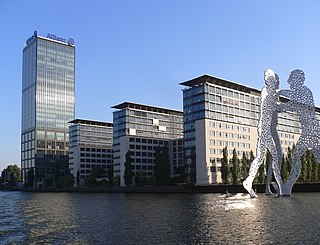
Alt-Treptow is a German locality in the borough of Treptow-Köpenick in Berlin. Known also as Treptow it was, until 2001, the main and the eponymous locality of the former Treptow borough.

Bus transport is the oldest public transport service in Berlin, the capital city of Germany, having been introduced in 1846. Since 1929, services have been operated by the Berlin Transport Company, although during the Cold War-era division of the city they operated in West Berlin only. In East Berlin the public transport agency split off from the BVG and rebranded as BVB, operating the buses in the Soviet sector of Berlin.

Ferry transport forms part of the transport network of Berlin due to the city's extensive network of rivers, lakes, and canals. 6 routes operate within the city boundaries and one serves the city of Potsdam, which are part of the common public transport tariff run by the Verkehrsverbund Berlin-Brandenburg (VBB).

Mahlsdorf is a locality (Ortsteil) within the Berlin borough (Bezirk) of Marzahn-Hellersdorf. Until 2001 it was part of the former borough of Hellersdorf.

Biesdorf is a locality (Ortsteil) within the Berlin borough (Bezirk) of Marzahn-Hellersdorf. Until 2001 it was part of the former borough of Marzahn.

Plänterwald is a German locality (Ortsteil) within the Berlin borough (Bezirk) of Treptow-Köpenick. Until 2001 it was part of the former borough of Treptow and the site of its former town hall.

Berlin is a city-state and the capital of the Federal Republic of Germany.
The Berliner Abendblatt is the leading weekly advertising paper in Berlin, Germany alongside the Berliner Woche and, along with Einkaufaktuell, one of the three main media for the collective distribution of the weekly brochures of retail chains in Berlin.



